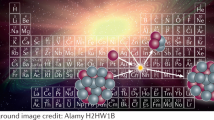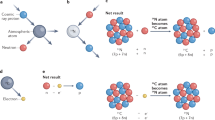Abstract
AT present the most likely view of the origin of the actinium series is that uranium II undergoes a dual change in which about 96 per cent, of atoms form ionium and the radium series, and the remainder form uranium Y, the product of which, proto-actinium, is the parent of the actinium series. An alternative view is that uranium I undergoes the dual change. In 1917 Piccard from a consideration of the Geiger-Nuttall relation put forward the view that the actinium series might arise from an isotope of uranium, actino-uranium, of atomic weight 240, present in ordinary uranium to the extent of about 8 per cent. Partly from experimental work carried out by Mr. W. P. Widdowson and myself, and partly from a survey of certain general relations in radio-activity, I have come to a different view, which I think represents the facts more adequately than these others. I agree with Piccard in thinking that the parent substance of the actinium series is an isotope of uranium, of atomic weight 240, not genetically connected with it; but differ principally in thinking the atomic weight of actinium is not 232, and that uranium Y is not the immediate parent of protoactinium.
This is a preview of subscription content, access via your institution
Access options
Subscribe to this journal
Receive 51 print issues and online access
$199.00 per year
only $3.90 per issue
Buy this article
- Purchase on Springer Link
- Instant access to full article PDF
Prices may be subject to local taxes which are calculated during checkout
Similar content being viewed by others
Author information
Authors and Affiliations
Rights and permissions
About this article
Cite this article
RUSSELL, A. The Relation of Actinium to Uranium. Nature 111, 703–704 (1923). https://doi.org/10.1038/111703a0
Issue Date:
DOI: https://doi.org/10.1038/111703a0
Comments
By submitting a comment you agree to abide by our Terms and Community Guidelines. If you find something abusive or that does not comply with our terms or guidelines please flag it as inappropriate.



